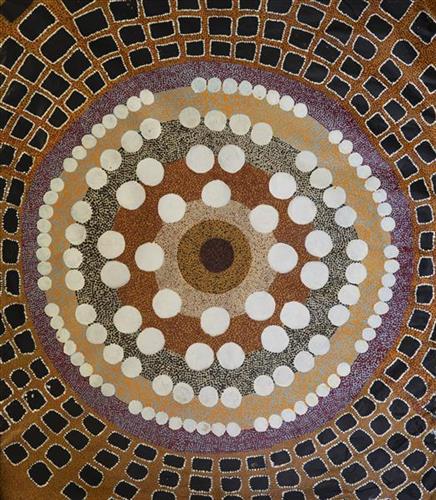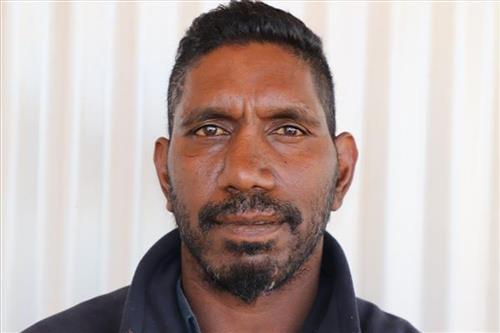Biography:
“I am Clifton Girgirba my nickmane is Gibon, I was born in Port headland, I grew up in Jigalong Community in the 80’s then I moved to camp 61, the first shelter school there, then I went back to Jigalong did school and language there, In ’87 [during the ‘Return to Country’ movement] we moved to Parnngurr with my foster mother Thelma (Judson). We all lived in the humpy’s first before the houses, no airport, no clinic, no shop. We just had a generator, we camped next to the hill side. We moved west before the houses came. The school opened in the 90’s it was the first building. I went to school doing art, sewing and carving that’s when I learned about art.
I moved around a bit to Wiluna, Woodstock, Punmu, Hedland and Newman throughout the 90’s. It was In 1993 I settled in Parnngurr, till today that’s my home. In those days I learnt how to go hunting, burn country learn about plants and animals, cultural things. All them old people were teaching us. Seed collecting and hunting you learn young, I learned a lot, all the waterholes and dreaming stories, like seven sisters. In 2002 when we got native title I was a young chairman for the school and the community, been on that board of directors for 10 years. Then came KJ (Kanyirninpa Jukurrpa, ranger organisation) and Martumili (Artists), I meet Gabrielle (Martumili Manager) and Peter Jonhston (KJ Dirctor), Muuki (Taylor) wanted to start up the KJ rangers, I got involved with Martumili doing interpreting first years before I started painting.
With the rangers I discovered some waterholes and soaks with my grandmother, studying language, clans, kinship, tribes we talk about those invisible boarders, areas, like rocky area, sand dune area, I started to learn about knowledge, then I knew who I was, I was just a person before but now because of my grandmother I know who I am.
I do mapping, leadership, and governance. When I got all this knowledge from the Country from my Elders: mother Thelma (Judson) Yimiri area and my grandmother Kumpaya (Girgirba) Kunawarritiji side , Muuki and Wokka Kiriwirri area and Ngamaru (Bidu) Pitu side. Then I really loved it, I have all the knowledge from them that I’m passing, now I’m doing my own program wama wangka (talking about alcohol).
I got nyniti (knowledge) from my grandmother for painting. I realised it’s better for my mind that I do painting, clear my mind and relax and keeps my mind focused, learn about country same time.
I’m a music man, started music with Wild Dingo Band and Parnngurr band, it’s about getting that band together, it feels good coz Martu people they like music in language, music is art, in the pujiman (traditional, desert dwelling) days they used to sing walking country. Wild Dingo Band do songs about wama (alcohol), kids, family, language, country and community we supporting and encouraging people to come back to community away from town and wama, same time its learning kids for their language.
Now I’m doing language in the schools too. My aim is two way learning teaching kids identity and to be proud of who they are. Kids are asking questions where am I from? Martu wangka sounds are different to English they got to know both to survive.
I’m also working in the justice system bringing government people to Martu people, to have a voice and partnership, a better future.
I love what I do.”




